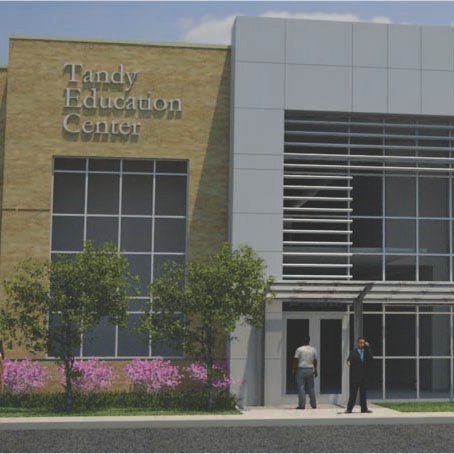A groundbreaking was held today for the $6.4 million Tandy Education Center at the OU-Tulsa Schusterman Center, 4502 E. 41st Street.
The 16,000 square-foot Tandy Education Center will feature the latest advances in medical simulation, and a training and feedback method in which students practice in lifelike circumstances using models or virtual reality. The center will include 10 exam rooms, two inpatient intensive care unit/emergency rooms, four interview consultation rooms, one apartment model for in-home situations, two debriefing rooms and a multipurpose training room with a separate area for training standardized patients.
“The Tandy Center will greatly expand learning opportunities for our students,” said OU President David Boren. “It is another important step forward for the planned University of Tulsa and University of Oklahoma joint School of Community Medicine in Tulsa.”
Funding for construction of the facility came from a grant from the Tandy Foundation. Additionally, the grant will support the purchase of equipment, including simulators, computers, software, cameras, monitors and trainers.
Simulation provides intensive and standardized experience for individuals and teams, allowing them to practice and learn prior to contact with live patients. The result is reduced medical errors, improved patient safety and reduced overall health care costs. During the simulation, students might treat a patient who is experiencing a heart attack or other emergency situations. After a simulated scenario is completed, students receive feedback and instruction from medical faculty and other student observers. In addition, all simulations are videotaped and reviewed by students and faculty for further educational instruction.
“The trustees of the A.R. and Marylouise Tandy Foundation are pleased and excited to be a part of this groundbreaking ceremony for the Tandy Education Center. We are confident that the OU School of Community Medicine will view this new facility as an integral component of its education and training of future health care professionals in our community,” said Paul Giehm, Senior Vice President for the Trustee and Advisory Committee of the Tandy Foundation.
The simulation center will be available to all OU School of Community Medicine students, physician assistant students, resident physicians and faculty as well as students in nursing, social work, human relations and other non-medical programs. The center will also offer community hours during which it can be utilized by medical personnel practicing in the Tulsa community who need additional training and certifications. It is anticipated that the simulation center will be used by approximately 1,000 health care professionals annually.
“We are pleased to be moving forward with the construction of the Tandy Education Center,” said Gerard P. Clancy, M.D., president of OU-Tulsa. “In the past, medical education has used a concept of ‘see one, do one, teach one.’ This new technology allows students to learn and strengthen clinical skills and manage hypothetical patient cases as members of a multi-disciplinary health care team. As they advance in their training, these technologies allow practicing physicians to improve their clinical skills. This center will not only train physicians, it will advance the safety of health care across our region. It will be a community-wide resource.”
OU and The University of Tulsa are currently working together to create a four-year community medical education program to help address Oklahoma’s low health status, low health systems performance and physician shortage. The simulation center will be an integral part of that program.
“Our city and our state face several challenges – among them a palpable health care disparity – that must be addressed by both public and private institutions if our communities are to thrive and our businesses are to prosper,” said TU President Steadman Upham. “The University of Tulsa’s partnership with OU is an important alliance in the strategy to improve the health and wellbeing of all residents. With critical support from the Tandy Foundation and other generous benefactors, we are able to provide better education for medical professionals and a brighter future for Tulsans and all Oklahomans.”
TU has an established core of science education and research programs, and OU has an established medical training program in Tulsa focusing on residency training and the third and fourth years of clinical medical student education. The new Tulsa School of Community Medicine will allow medical students to complete all four years in Tulsa. The first class of students in the Tulsa School of Community Medicine is expected to start in the fall of 2015.
The program will build upon the concept of a School of Community Medicine, which was established at OU-Tulsa in February, 2008, with a $50 million gift from the George Kaiser Family Foundation, with emphasis on helping those most in need of medical care. The curriculum, designed and supported by TU and OU faculty, will focus on priorities such as improving the health of entire communities, improvement in public health disparities, and recruitment of students with altruistic goals, health systems improvement and interdisciplinary work.



